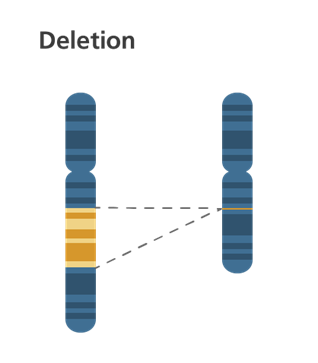Deletions and microdeletions
Loss of genetic material from the genome is known as a deletion or, if the deletion is too small to be seen under a microscope, a microdeletion.
What are deletions and microdeletions?
Loss of genetic material from the genome is known as a deletion (a type of copy number variant). Deletions can vary in size, and if a deletion is too small to be seen under a microscope, it is called a microdeletion.
We know that our genetic information is stored in DNA, which is then tightly packed into chromosomes, and that genes are made up of stretches of DNA. The largest human chromosome (chromosome 1) contains more than 2,000 protein-coding genes and the smallest (chromosome Y) contains just 71.
When a section of a chromosome is deleted, the genes present in that section will also be deleted, resulting in a loss of genetic material. The impact of the deletion on an individual depends on which genes, or parts of genes, have been deleted.

Figure 1: A deletion, which causes part of a chromosome to be missing
From yourgenome, reproduced under Creative Commons Attribution 4.0 International (CC BY 4.0).
Does the size of the deletion matter?
Deletions can vary in size and have a range of effects. The size of the deletion, however, does not necessarily correspond to the size of the effect.
A single base deletion within a gene can change the entire reading frame and therefore every subsequent amino acid in the protein, thus changing its function. A change in the reading frame can also introduce a stop codon earlier in the sequence, which means that the protein will be shorter than it should be, again affecting its function.
A deletion of a large tract of non-coding DNA may or may not have an effect on phenotype. Some non-coding DNA regions have important regulatory functions, while others can be deleted with little apparent impact.
Clinical examples
- Genetic testing: While large deletions can sometimes be visualised by a karyotype, a microarray is the gold standard for diagnosing such copy number variants.
- Deletion and microdeletion syndromes: Depending on the location of the deletion and the genes involved, there is significant variation in how different syndromes may present. Features that can be found in some deletion and microdeletion syndromes include intellectual disability, dysmorphia and congenital anomalies.
- Contiguous gene deletion syndromes: These occur when multiple genes are deleted from a chromosomal segment.
Key messages
- Deletions are a type of copy number variant that arise when regions of the genome are deleted.
- The clinical relevance of deletion and microdeletion syndromes depend on the region of DNA that is deleted and the genes involved.
Resources
For clinicians
- Unique (Understanding Chromosome & Gene Disorders): Deletions and microdeletions (PDF, two pages)
For patients
- Unique (Understanding Chromosome & Gene Disorders): Deletions and microdeletions (PDF, two pages)